This Best Mashed Potatoes recipe is the ultimate guide to homemade restaurant-quality mashed potatoes made easy. Ultra creamy and smooth with no lumps – all the best pro tips and tricks for the best mashed potatoes!
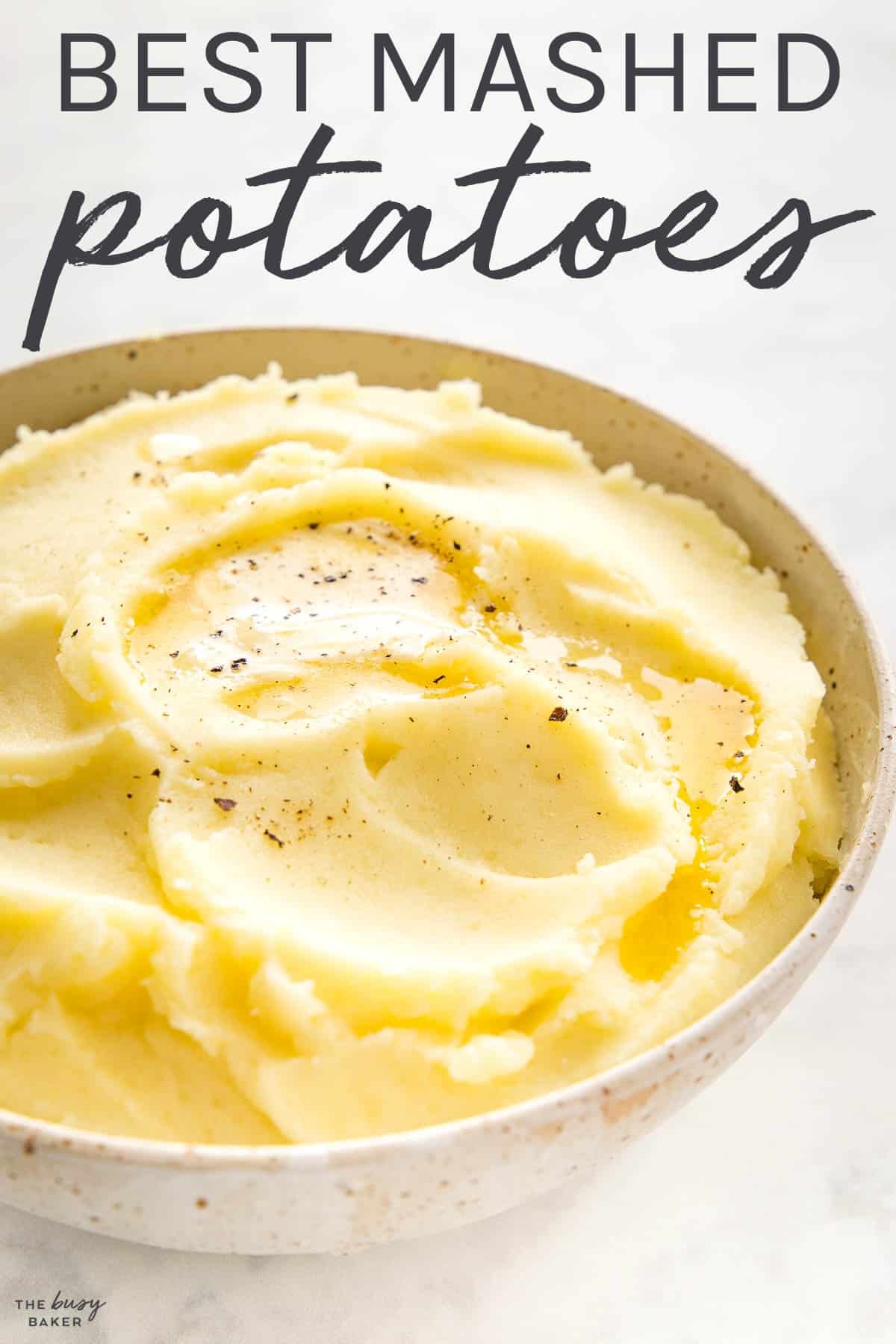
Estimated reading time: 1 minute
Mashed potatoes might be the most beloved comfort food side dish of all time – they’re enjoyed on dinner tables all over the world for everything from quick weeknight meals to holiday feasts.
Making homemade mash can be a bit of a gamble, and if you’ve ever had lumpy, dry potatoes you’ll know exactly what we mean. This Best Mashed Potatoes recipe is our comprehensive guide to the BEST homemade mashed potatoes you’ll ever make. We’ll show you how to make restaurant-quality potatoes the easy way – everything from choosing the right potatoes, tips for how to prepare and cook them the right way, how to flavour your mashed potatoes perfectly, and how to ensure you end up with smooth lump-free mashed potatoes.
Trust us – they are oh so creamy, ultra smooth, and perfect for serving alongside all your favourite main dishes like Roasted Prime Rib, your holiday turkey, grilled meats or fish, or even meatballs!
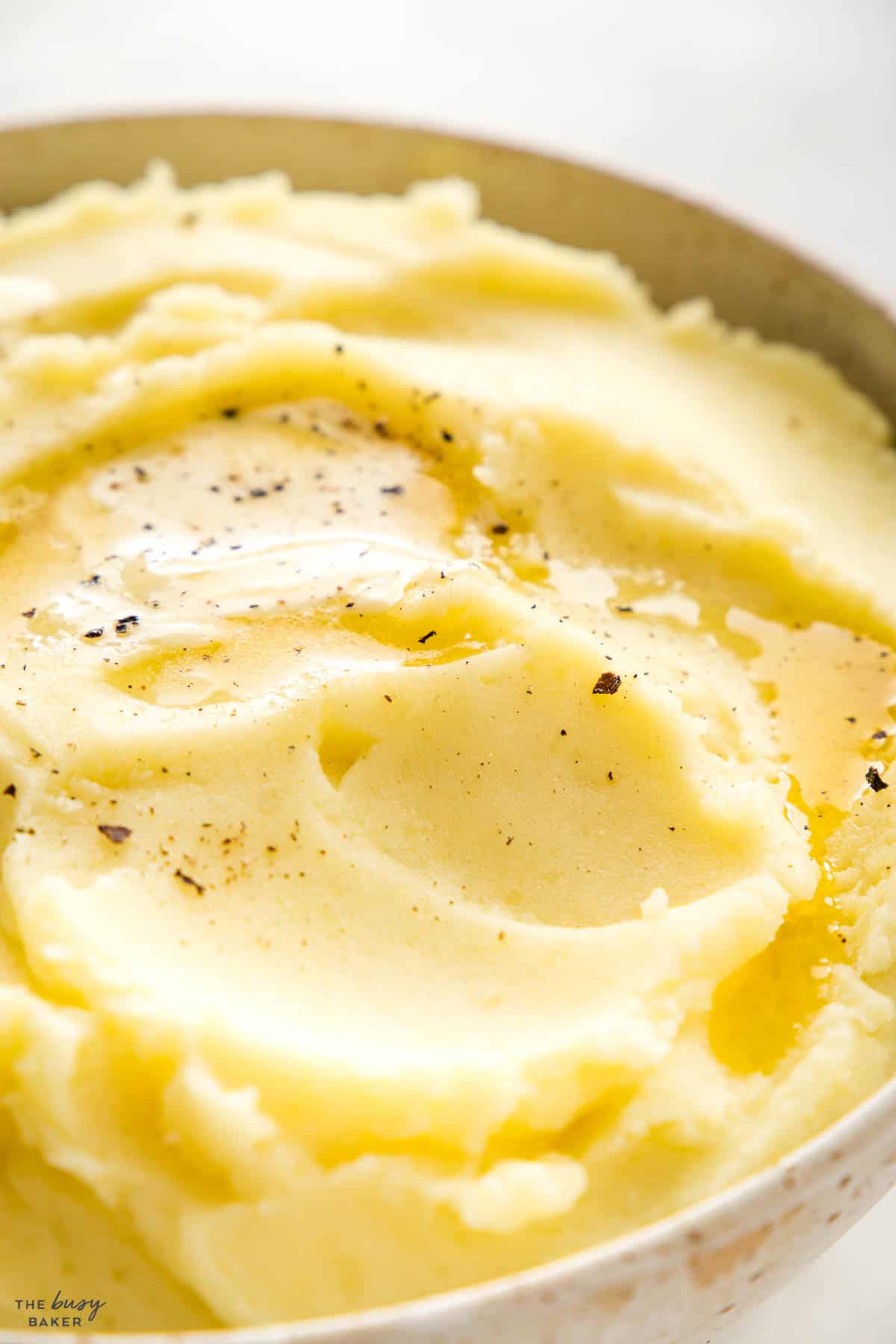
The most important choice is which variety of potato to use. Starchy potatoes are superior to waxy potatoes when it comes to mashing – for the perfect mash, choose starchy Russets or Yukon Golds. They’re high in starch and low in moisture, breaking down easily for a fluffy, smooth texture when turned into mashed potatoes.
Waxy potatoes, such as red or fingerling varieties, new potatoes, or baby potatoes, have a higher moisture content and hold their shape well, making them ideal for roasting. Their high moisture content and hardier texture can lead to a denser, gummier mash.
Butter is an incredibly important ingredient when it comes to the flavour and texture of homemade mashed potatoes. Premium, high-fat butter will give your mashed potatoes a creamy, rich taste. When it comes to salted vs. unsalted butter, we recommend unsalted butter because it allows you to adjust the salt level to your preference.
Half and half cream adds more richness and softens the mixture, making them moist and fluffy. The important thing to remember when adding the butter and cream is to heat the dairy first. Adding cold dairy to hot potatoes can create a gluey and sticky texture, so be sure to heat them in the microwave or in a pot on the stove first before combining them with the cooked potatoes.
Be sure to wash them well and peel them. Cut your potatoes into large, even chunks, about 6-8 pieces per large potato. This ensures they cook evenly and don’t become waterlogged, which can make the mash too watery and cause it to separate. Unevenly sized chunks of potato can cause the potatoes to cook unevenly, leading to inconsistent texture and lumps with some pieces overcooked and others undercooked.
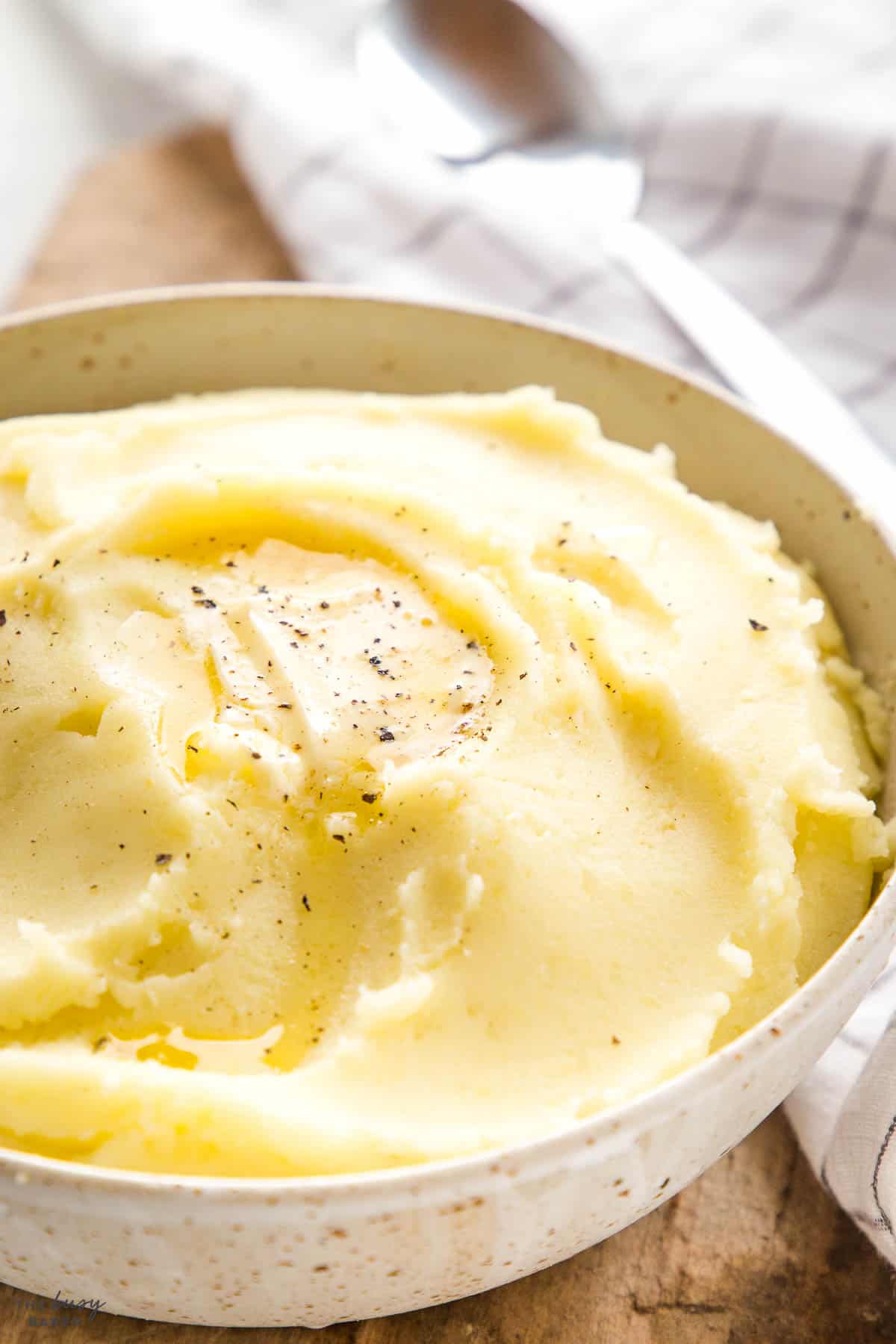
Begin by placing your potatoes in room temperature water. This allows them to heat up gradually and cook evenly, preventing the outsides from cooking too quickly while the insides remain hard.
The boiling time varies depending on the size of your potato chunks. Typically, it takes about 15-20 minutes after the water starts boiling. They are done when they are tender enough to be easily pierced with a fork but not falling apart.
Adding flavour doesn’t just happen after the potatoes are cooked. Salting the water is a critical step to creating ultra flavourful mashed potatoes. This step seasons the potatoes from within, providing a deeper flavour than just salting the finished mash.
Our favourite mashed potato trick is to add whole garlic cloves to the water as well. They’ll cook with the potatoes and infuse the potatoes with their flavour.
When the potatoes are drained the boiled garlic cloves will remain and can be mashed right along with the potatoes, creating a subtle garlic flavour in the mashed potatoes that’s absolutely delicious and not overpowering. It’s a super easy step that makes a BIG impact on the final result.
After boiling, drain the potatoes well to remove excess water by pouring the potatoes into a colander. Resist the urge to rinse them – this will wash off important starch which will help create creamy mashed potatoes.
A potato ricer (paid link) is our most recommended tool for achieving smooth, lump-free mashed potatoes. It gently breaks the potatoes without releasing too much starch, which can make them gluey and sticky.
If you don’t have a potato ricer, hand mashing with a potato masher is your best bet. Be sure to mash gently, just until no lumps remain. Over-mashing can release too much starch from the potatoes, leading to a heavy, gluey and sticky texture. For this reason we don’t recommend using a hand mixer.
It’s important to taste the mashed potatoes before adding too much salt. Be sure to add only as much salt as needed – remember, you can always add more, but you can’t remove salt that’s been added.
We recommend adding white pepper to mashed potatoes only because of the colour, but feel free to add black pepper if that’s all you have on hand.
Serve while they are hot and fresh. As they cool, they can become denser and lose their creamy, fluffy texture. If you need to keep them warm before serving them, keep them warm in a covered pot or in a casserole dish in an oven on low heat.
Garnishes like chopped fresh herbs, a pat of butter, and cracked black pepper add visual interest.
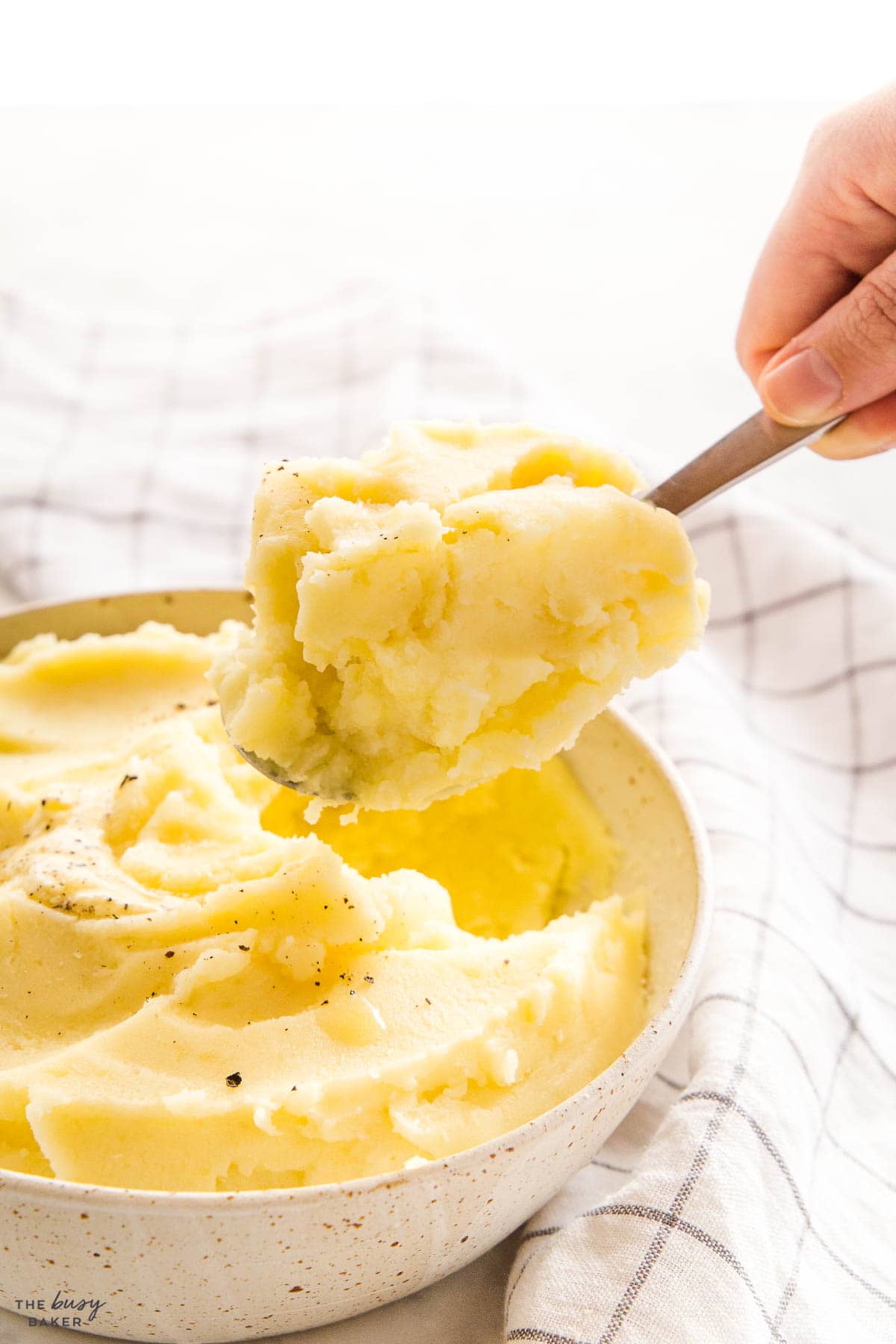
Here’s a list of possible issues you might encounter and mistakes people often make while making homemade mashed potatoes, and how to fix them:
- The Cause: Over-boiling or cutting the potatoes too small can lead to waterlogged potatoes.
- How to Fix it: If they’re slightly watery, place them in a colander or strainer lined with some paper towel so some of the moisture can drip out.
- The Cause: Over-mashing or using a high-speed mixer releases too much starch.
- How to Fix it: Unfortunately, once they’re gluey, it’s hard to reverse. Consider adding them to a recipe that calls for mashed potatoes, like these leftover mashed potato pancakes.
- The Cause: Undercooked potatoes or insufficient mashing can leave lumps in the potatoes.
- How to Fix it: Continue mashing until smooth or use a potato ricer to help remove remaining lumps. If you don’t have a potato ricer, use a potato masher with the smallest holes possible to break up the lumps.
- The Cause: Insufficient seasoning can cause them to have a bland taste.
- How to Fix it: Add a little more salt and pepper to taste. Remember, it’s easier to add more seasoning than to fix the potatoes once you’ve over-seasoned them.
- The Cause: Not enough butter or cream can cause dryness, as can overcooking.
- How to Fix it: Gently mix in additional warm cream or melted butter to reach the desired creamy texture.
- The Cause: Potatoes can oxidize if they are left raw, cut and exposed to the air for too long.
- How to Fix it: This is mostly a visual issue and doesn’t affect taste or texture too much. To prevent oxidation, cook the potatoes immediately after cutting them.
- The Cause: Cutting the potatoes in inconsistently sized pieces can cause them to cook unevenly.
- How to Fix it: Next time, ensure all potato pieces are roughly the same size. You can also remove the overcooked pieces and continue cooking the rest until they’re done.
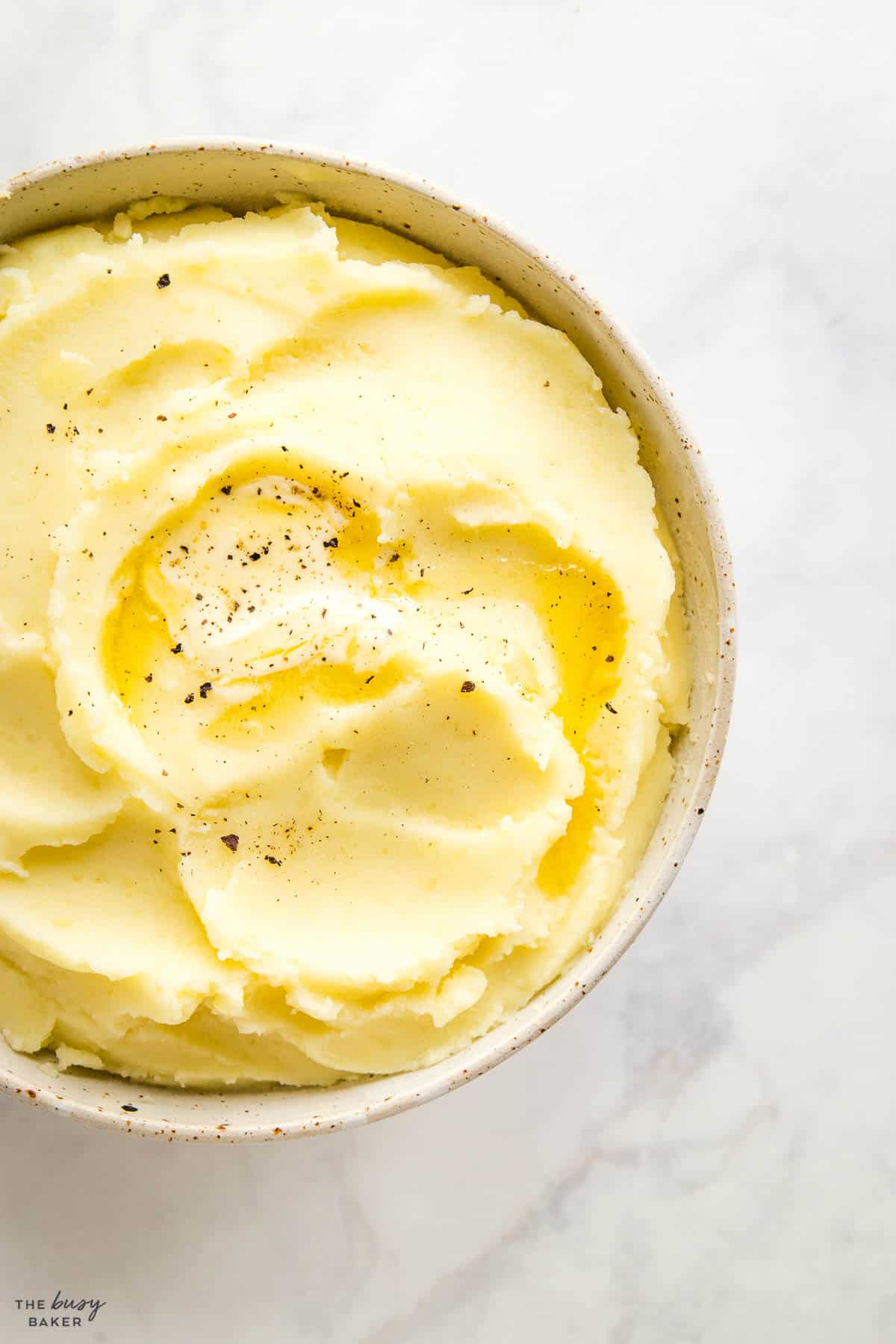
You’ll only need basic kitchen equipment to make this mashed potatoes recipe. Here’s a list of the equipment we recommend having on hand to make this recipe (paid links):
- a large pot
- a colander
- a vegetable peeler
- a large knife
- a cutting board
- a measuring cups and spoons
- a liquid measuring cups
- a Potato Ricer
- a large serving bowl
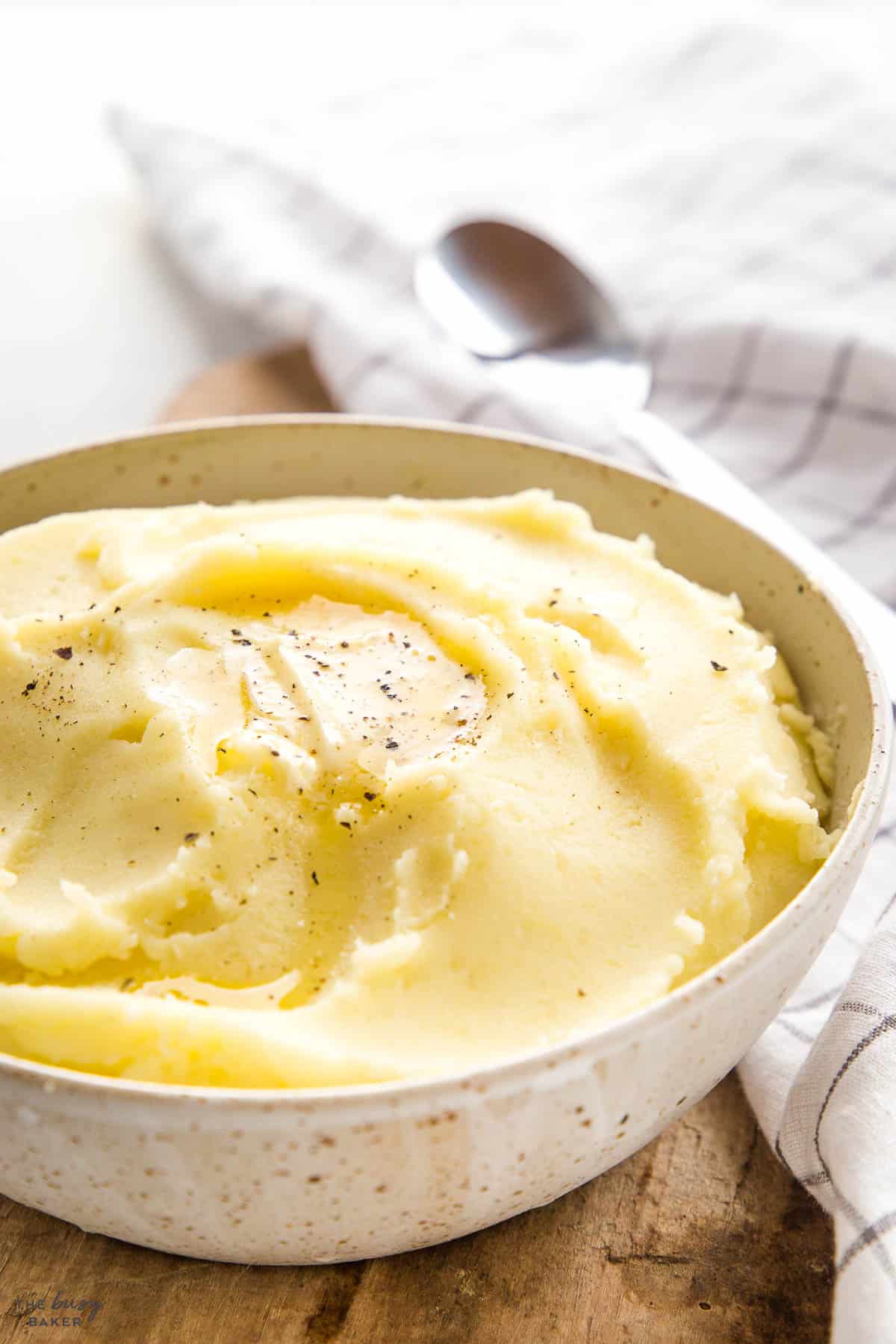
Here’s a list of all the ingredients we need to make this mashed potatoes recipe (paid links):
- 6 large Yukon Gold potatoes or any white or yellow potatoes, peeled and cut into quarters or eighths
- 3 teaspoons salt
- 4 cloves garlic
- 1/3 cup butter
- 1/2 cup half and half cream
- 1/2 teaspoon salt
- 1/2 teaspoon white pepper
- more butter, salt and pepper for serving (optional)
For people with dietary restrictions or preferences, there are ample substitutes. Vegan butter can be a good substitute for dairy butter, and coconut cream or oat cream is a good substitute for half and half. These alternatives can still create a creamy, delicious mash while catering to dietary needs.
Our personal recommendation for making this mashed potato recipe dairy-free and vegan is to use vegan butter and oat cream. Oat cream has a very mild, almost dairy-like flavour that just disappears, unlike other vegan creams that can add a strong flavour (like cashew cream or coconut cream).
Want to take this mashed potatoes recipe to the next level? Try one of these delicious variations:
- Garlic: Mash roasted garlic cloves into the potatoes for an intense garlic flavour.
- Cheesy: Stir in grated cheddar or some cream cheese for a cheesy twist.
- Herb-Infused: Add fresh herbs like rosemary or thyme to the cooking water and let the oils from the herbs infuse the potatoes while they cook. Mix in chopped fresh herbs to the potatoes after mashing.
- Loaded: Add bacon bits, sour cream, chives, and shredded cheese to the potatoes after they’ve been mashed.
- Caramelized Onion: Mix in caramelized onions for a sweet and savoury flavour.
- Truffle: Stir in truffle oil for a luxurious, restaurant-quality flavour.
- Pesto: Blend in homemade or store-bought pesto.
- Horseradish: Add prepared horseradish for a pungent flavour. This is a great variation for serving with steak or roast beef.
Looking for a keto or low-carb version of this mashed potatoes recipe? Try our AMAZING Mashed Cauliflower recipe!
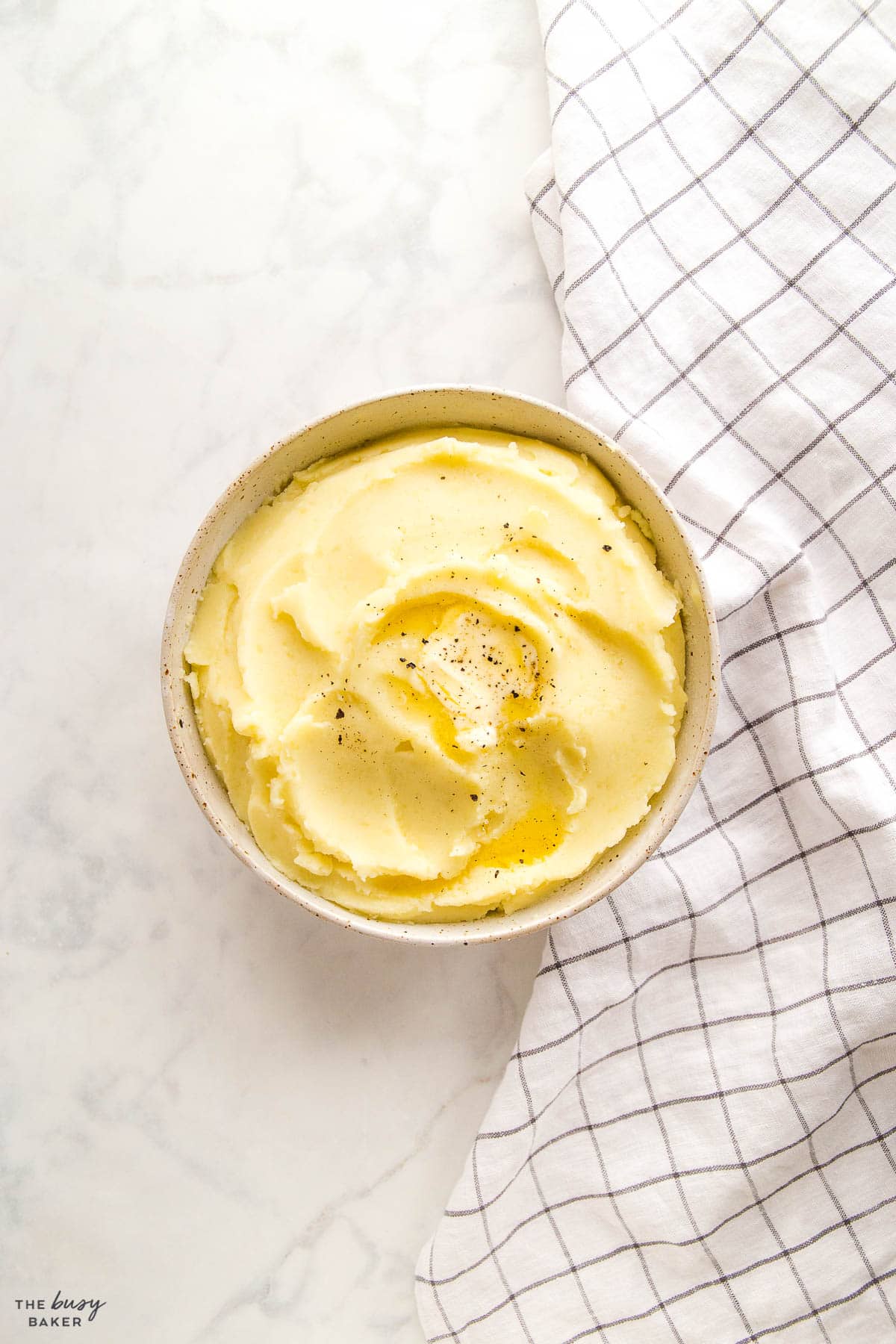
Time needed: 40 minutes
Follow these steps for the perfect restaurant-quality mash!
- Peel and cut the potatoes.
Wash, peel and cut the potatoes into 4-8 pieces each. The pieces of potato should be about the size of an egg.
- Add the potatoes to cool or room temperature water.
Let the potatoes heat up with the water.
- Salt and flavour the water.
Add a generous amount of salt to the cooking water and add the garlic cloves to the water too.
- Boil and avoid overcooking,
Cook until the potatoes are fork tender, about 15-20 minutes.
- Use a potato ricer.
Create the perfect soft, fluffy and lump-free mashed potatoes with a potato ricer instead of a potato masher or hand mixer.
- Add butter and cream.
Heat the butter and cream and add to the potatoes, mixing them in gently.
- Season and serve.
Season with more salt and pepper and serve.
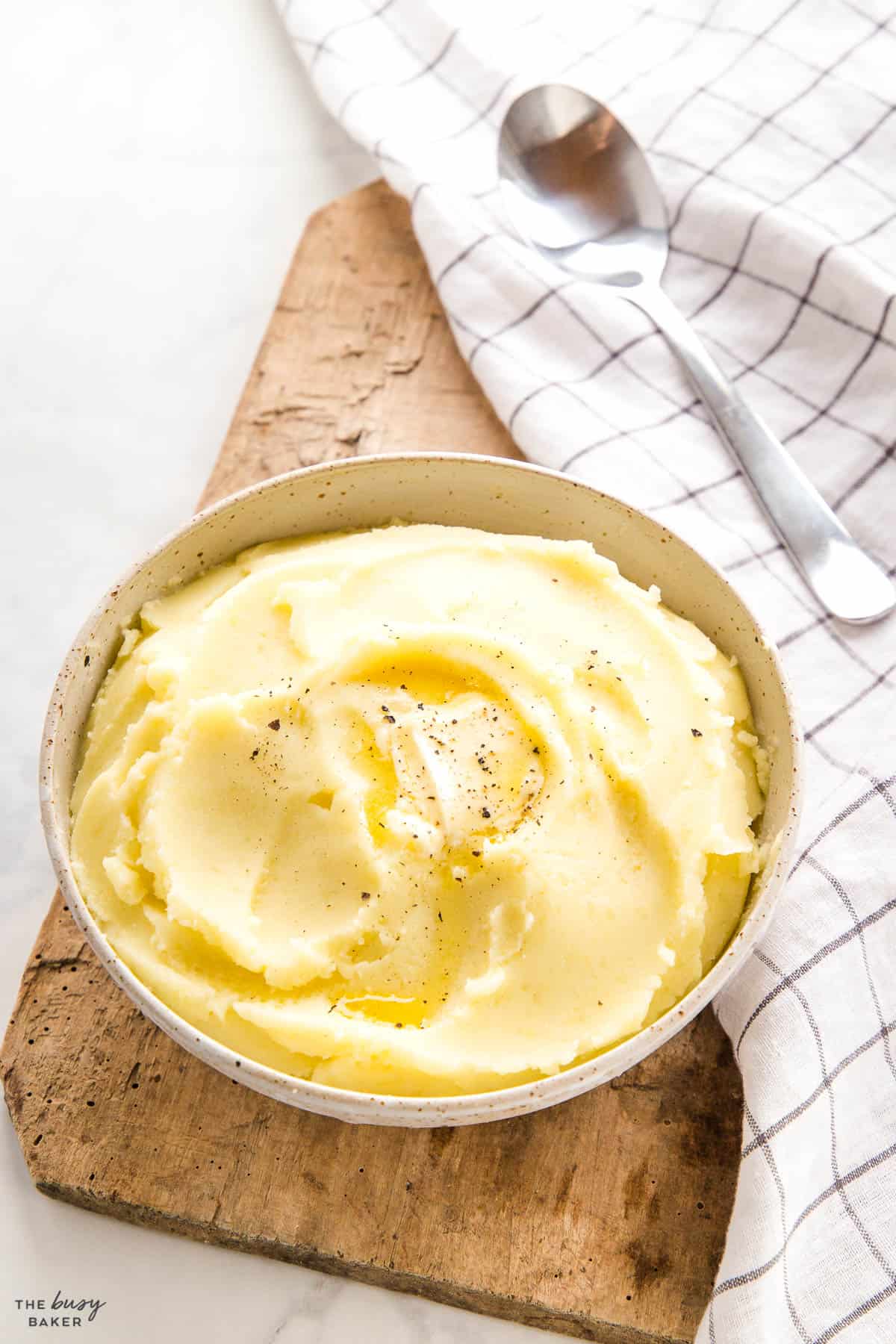
Why type of potato is best for mashed potatoes?
Starchy potatoes like Russets or Yukon Golds are generally considered best due to their texture and ability to absorb butter and cream.
Can I combine Russets and Yukon Gold Potatoes to make mashed potatoes?
Yes. Combining Russet (starchy) and Yukon Gold (all-purpose) potatoes can give you a nice balance of fluffiness and flavour.
Should you add salt when boiling potatoes?
Yes. Adding salt to the water is critical for adding flavour to the potatoes. Salting the water adds more flavour than salting them after they’ve been mashed.
How many potatoes do I need for mashed potatoes?
On average, one medium-sized potato per person is a good rule of thumb.
How many mashed potatoes for 25 people?
For 25 people, plan on preparing about 8-10 pounds of potatoes. This quantity assumes a serving size of about 3/4 cup per person.
How long to boil potatoes?
Boil until they are fork-tender, which typically takes 15-20 minutes depending on the size of the chunks.
Can you overcook mashed potatoes?
Yes, potatoes can disintegrate and become waterlogged if overcooked. Be sure to set a timer when cooking potatoes and stop the cooking process when they’re fork-tender.
Do the potatoes need to cool before mashing?
No, we recommend mashing them while they’re hot to create a smooth texture.
How to keep mashed potatoes warm?
We recommend using your Slow Cooker or Crock Pot on the “Keep Warm” setting to keep them warm until you’re ready to serve.
Are mashed potatoes healthy to eat?
When made from real ingredients without preservatives, they are much healthier than most conventional pre-made or restaurant dishes.
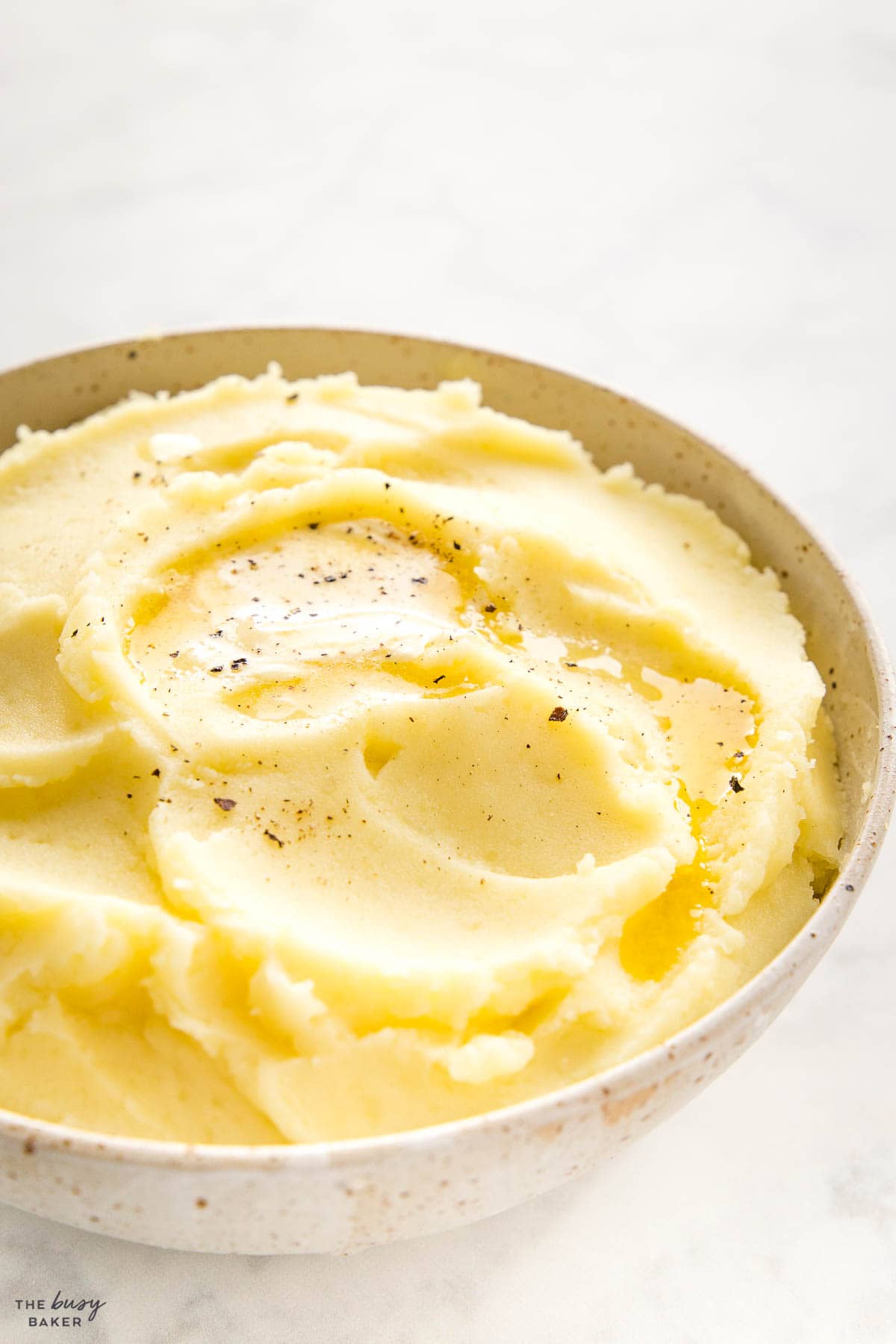
We hope you love this mashed potatoes recipe as much as we do! Let us know in the comments below, what’s your favourite side dish to make for the holidays? We’d love to know!
Watch the video below to see exactly how we make this recipe. You can find many more deliciously simple recipe videos on our YouTube channel!
If you made this, share a photo!
Are you trying this recipe? Use the comment form below to share your take; now with support for image uploads and comment voting!
Best Mashed Potatoes
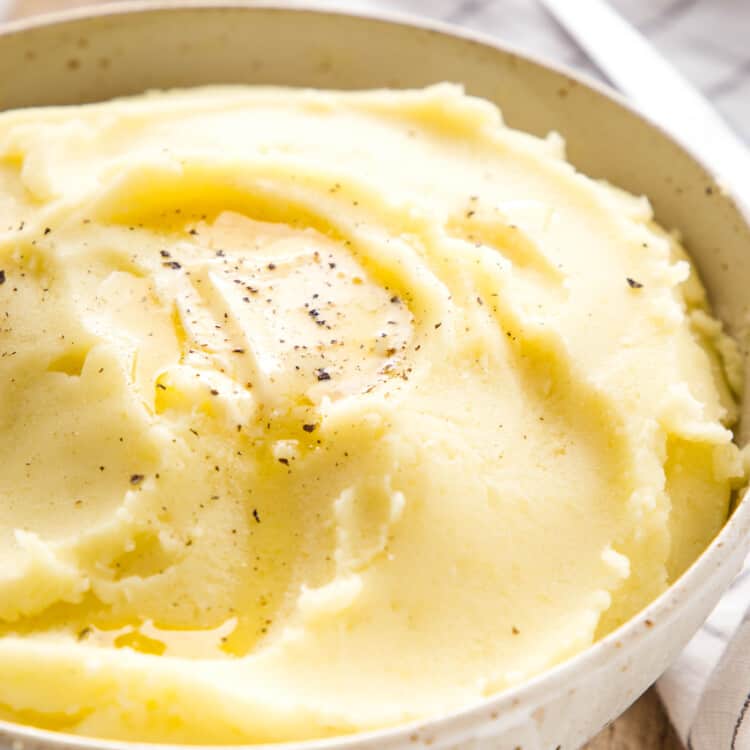
Recipe: Equipment
Recipe: Ingredients
- 6 large Russet or Yukon Gold potatoes or any white or yellow potatoes, peeled and cut into quarters or eighths
- 3 teaspoons salt
- 4 cloves garlic
- 1/3 cup butter
- 1/2 cup half and half cream
- 1/2 teaspoon salt
- 1/2 teaspoon white pepper
- butter, salt and pepper for serving
Recipe: Instructions
- Add the peeled and cut potatoes to a large pot and add water just until the potatoes are covered.
- Add the sea salt and whole garlic cloves and bring to a boil over high heat.
- Once the water begins to boil, reduce the heat to medium-high so the water reaches a simmer. Continue simmering until the potatoes are fork-tender (about 15-20 minutes).
- Right before the potatoes are finished cooking, add the butter and the half and half to a microwave-safe bowl and microwave on 50% power until the mixture is warm and the butter is melted.
- Drain the potatoes in a colander and rice the potatoes with a potato ricer, adding them back into the pot after you push them through the potato ricer (the pot should be off the heat). If you don't have a potato ricer, use a potato masher and mash gently, just until smooth.
- Add the warm butter and cream mixture to the pot with the potatoes, along with the sea salt and pepper. Stir just until everything is combined
- Serve immediately while hot. Add a little bit of butter on top with some freshly cracked pepper for serving (and more salt, if desired).
Recipe: Notes
Storage Instructions
Store any leftovers in an airtight container in the fridge for up to 3 days. Reheat in the microwave until heated through.Freezer Instructions
Freeze leftovers in an airtight container in the freezer for up to 3 months. Thaw at room temperature and reheat in the microwave until heated through.Make Ahead Instructions
Because of the nature of this dish and the importance of serving it when fresh, we don’t recommend making it ahead of time. However, if you must make it ahead of time a great way to keep them warm is in the CrockPot or slow cooker on the “Keep Warm” setting. This is a great trick for holiday meals or when you’re hosting a big crowd for dinner.Recipe: Nutrition
Notice: Nutrition is auto-calculated, using Spoonacular, for your convenience. Where relevant, we recommend using your own nutrition calculations.

EASY NO-FAIL HOLIDAY RECIPES AND COOKING & BAKING TIPS
Get my easy no-fail holiday meals e-cookbook!
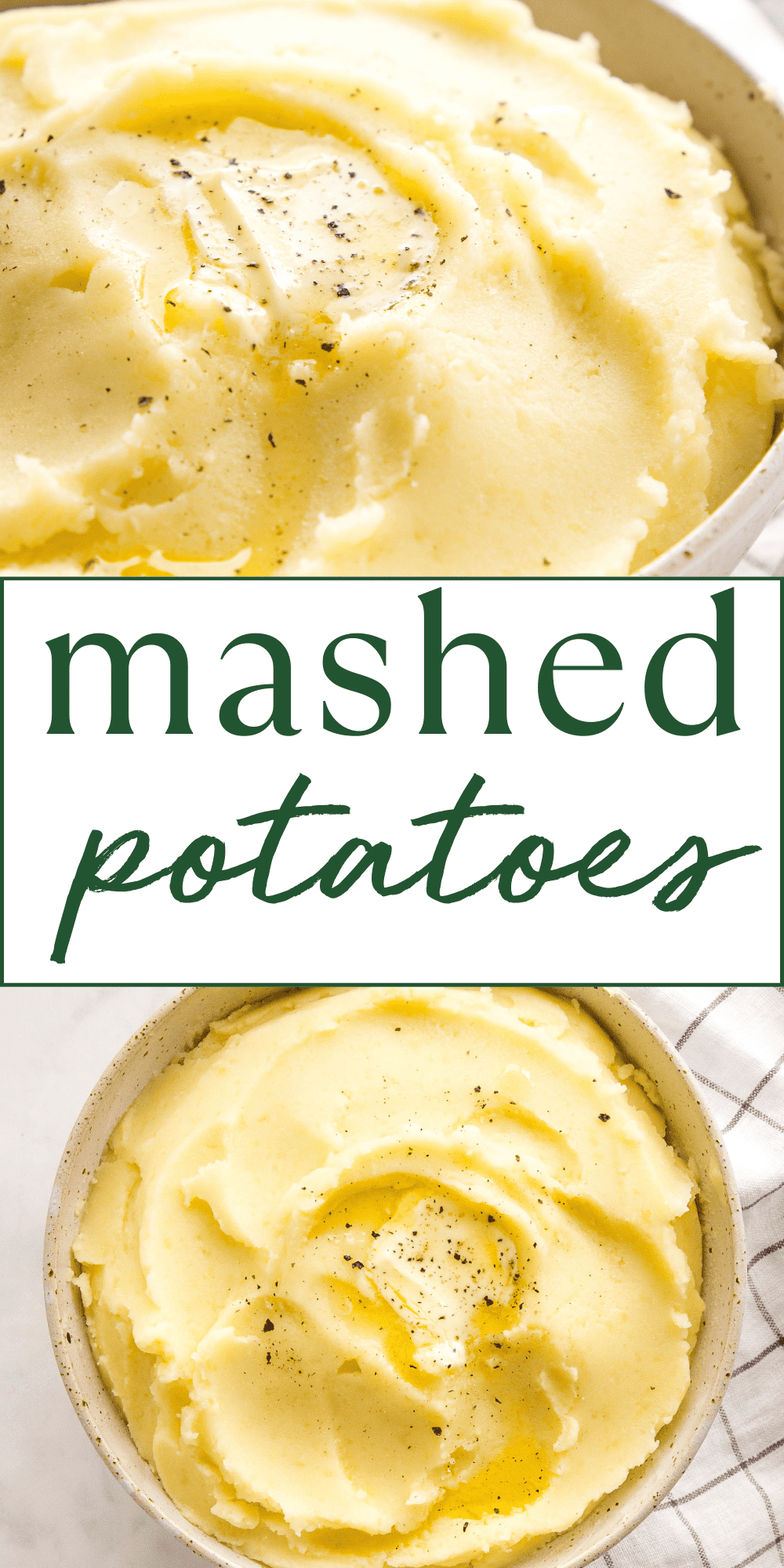

Can you please share what oat cream you use? Like what brand? Thank you!
This is the oat cream we used https://amzn.to/3GTF1e2 (affiliate link) Hope this helps ☺️